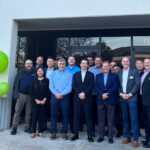ASIA ELECTRONICS INDUSTRYYOUR WINDOW TO SMART MANUFACTURING
FUJI Renews Pitch for Novel Products to Meet New Needs
Recently, FUJI Corporation has implemented a top management restructuring with Nobuyuki Soga taking the helm as Chairman and Chief Executive Officer. Meanwhile, Joji Isozumi assumed as President and Chief Operating Officer.
Under the new management system, FUJI aims to achieve new development implementing speedy actions in the age of rapid changes.
FUJI deploys two businesses for the global market. First, the robot solution business, centers on mounters. This accounts for about 90 percent of the company’s sales. Second is the machine tool business.
Strengthening FUJI Smart Factory
Isozumi said, “Since its founding in 1959, our company has embraced innovative spirit as a driving force to produce the world’s leading-edge mounters and machine tools. Particularly, the company places highly on its robot solution business centering on mounters.”

Previously, Isozumi said there is a high ratio of mounters vis-à-vis the volume production of smartphones. In terms of market, China has the highest share.
“Presently, however, we are expanding the lineup of products that support the multi-lateralization of the market, ranging from automotive to network printed circuit boards. As part of the effort, the company brought to market the AIMEXR scalable all-in-one placement machine. On manufacturing floors, there is a growing need for automation to balance the rising labor costs and shortages of operators have been increasing.”
He said the company will further strengthen the proposal of FUJI Smart Factory (FSF). In addition, Isozumi said, “We set sights on the entire production floor not limited to the mounting line. In addition, we provide automation solutions, including peripheral equipment and software, by strengthening collaborations with partner companies.”
Furthermore, Isozumi said the company’s forte in the machine tool business is a turnkey business for the automotive industry. Going forward, FUJI will pursue the commercialization of composite processing machines that support variable-mix, variable-volume production in the general-purpose machines market as well.
Investments for Innovations
In 2017, while serving as General Manager for Business Development, Isozumi established FUJI Innovation Lab in Silicon Valley in the United States. Isozumi took the post of Director of the new company.
Meanwhile, in pursuit of the company’s open innovation pitch to merge technologies and ideas inside and outside the company, FUJI invested in RIOS Corporation. The American technology startup specializes in artificial intelligence (AI)-powered tactile robot technologies. Together, the companies have developed a new robot technology using AI. Thus, FUJI has been actively promoting collaborations with other companies.
In 2018, FUJI made Fasford Technology Co., Ltd. (FFT), a bonding equipment manufacturer, as its subsidiary through merger and acquisition (M&A). Regarding FFT, Isozumi said, “FFT primarily produces die bonders for memories such as DRAMs and NAND devices. We have been jointly developing products in new fields by combining FFT’s semiconductor packaging process. Particularly, with high expertise and general versatility of electronic components mounters.”
FUJI’s production base for electronic components mounting robots is the Okazaki Plant in Aichi Prefecture. Meanwhile, its production base for machine tools is the Toyota Plant in Aichi Prefecture, both in Japan. At its Kunshan Plant in Jiangsu province in China, the company produces solder paste printers for the mounting process and machine tools.

On the other hand, to bolster production capacity for electronic component mounting robots, FUJI is constructing a new factory building at the Okazaki Plant. The new factory building will have four stories and a total floor area of 32,500sq.m. The total construction cost is about ¥10 billion. It will become a state-of-the-art factory installed with robot technologies and internet of things (IoT) technologies. Operations are planned to commence in September 2024.
Automation to Improve Lives
Meanwhile, Soga has made sure to build an open corporate culture since he assumed as president in 2009. Particularly, he encourages employees’ exchange of ideas and active discussions. Moreover, he took the initiative to help some ideas coming out of these activities to take shape as new businesses.
In 2016, FUJI commercialized Hug mobility support robot, which aids elderly and physically challenged people at nursing facilities to transfer from the bed to a wheelchair and vice versa. Thus far, the company has sold more than 3,000 units, including delivery to hospitals in Korea. Hence, the company has been building a track record of good sales.
FUJI deploys the Quist public locker system, a solution that diversifies means of delivering goods. Particularly, this system has started to gain ground in the distribution retail industry.
The Quist delivery locker system supports working people allowing them to receive products they bought online in the locker. Various industries have adopted FUJI’s Quist system. Among them are Japan Post Co., Ltd., as well as home centers and pharmacies.
Particularly, amid the COVID-19 pandemic, demand for Quist rapidly expanded as a non-face-to-face, non-contact solution.
Moreover, in Chiryu in Aichi Prefecture, the location of its head office, FUJI opened THANK, a learning facility to teach English to children in the region. Particularly, through various curricula including science.
Operations of THANK started in September 2016. At the facility, children enjoy learning. Isozumi said, “I would like to increase businesses that make people’s lives more enriched through automation. We will continue to take challenges to create further innovative technologies and new values.”




